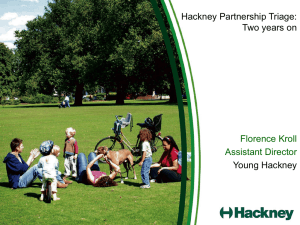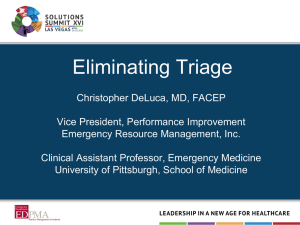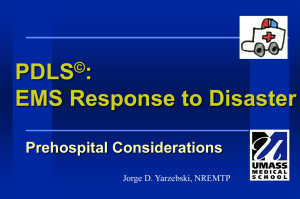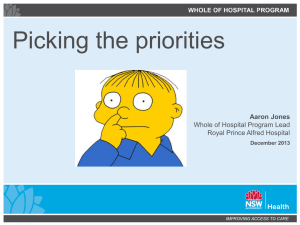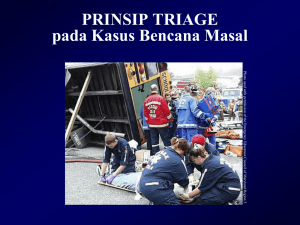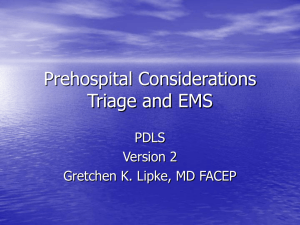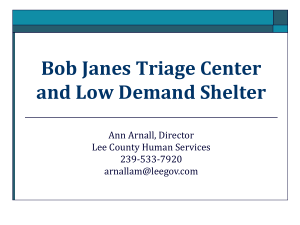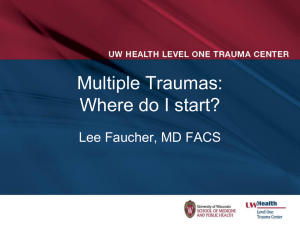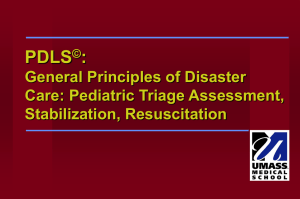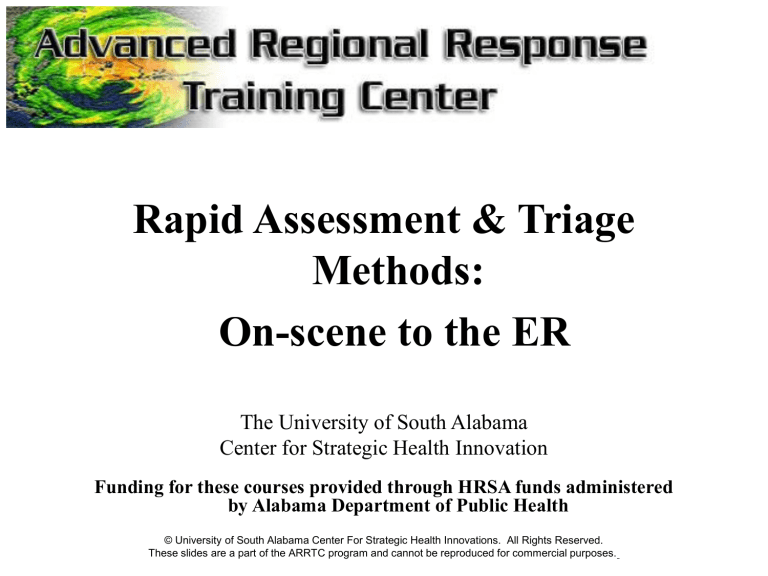
Rapid Assessment & Triage
Methods:
On-scene to the ER
The University of South Alabama
Center for Strategic Health Innovation
Funding for these courses provided through HRSA funds administered
by Alabama Department of Public Health
© University of South Alabama Center For Strategic Health Innovations. All Rights Reserved.
These slides are a part of the ARRTC program and cannot be reproduced for commercial purposes.
Objectives
1.
Identify situations when standard triage methods
may be inadequate.
2.
Identify appropriate triage locations for different
types of mass casualty events.
3.
Identify MCI triage acronyms:
MASS, START, JumpSTART, SLUDGEM
4. Identify discipline-specific staffing needs for the
four (4) main triage categories.
Mass Casualty Incident: What Is It?
An incident can be considered a
mass casualty incident
whenever the number of victims
is greater than
your resource capability
to provide usual and customary
standards of care.
On-Scene Rapid Assessment
1. Immediate Scene Assessment
On-Scene Rapid Assessment
2. Set-up of Victim Staging Areas
On-Scene Rapid Assessment
3. Rapid Assessment and Triage
•
Method # 1
START : Simple Triage And Rapid Treatment
•
Method # 2
JumpSTART (Pediatric Version of START)
•
Method # 3
MASS : Move, Assess, Sort, & Send
Color Coded Triage Categories
Black (dead or non-salvageable)
Red (immediate)
Yellow (delayed)
Green (ambulatory / minor injuries)
START
(Simple Triage And Rapid Treatment)
Developed by staff at Hoag Hospital and the Newport Beach
Fire Department Newport Beach, CA. in 1986
START: RPM 30 / 2 / Can Do
• Components of Assessment:
Ambulating = Green Triage Category
Respirations ~ > 30 = immediate
Perfusion ~
> 2 = immediate
Mental status ~ Can’t Do = immediate
START Triage
RESPIRATIONS
PERFUSION
NO
Over 30/min
Position Airway
NO
Nonsalvageable
Under 30/min
YES
YES
Immediate
Immediate
Cap refill
> 2 sec
Control
Bleeding
Immediate
Cap refill
< 2 sec.
MENTAL
STATUS
Failure to follow
simple commands
Can follow
simple commands
Immediate
Delayed
JumpSTART:
Pediatric START Triage Method
Developed by
Lou E. Roming MD, FAAP, FACEP
Miami Children’s Hospital
Miami-Dale Fire Rescue Department
Medical Director, FL/5 DMAT
The JumpSTART Field Pediatric Multicasualty Triage System ©
(Patients aged 1- 8 years)
Identify and direct all ambulatory patients to designated
Green area for secondary triage and treatment. Begin
assessment of nonambulatory patients as you come to them.
Proceed as below:
Black
Red
Yellow
Green
MINOR
Spontaneous respirations?
= Deceased/expectant
= Immediate
= Delayed
= Minor/Ambulatory
YES
NO
Check resp. rate
Open airway
Spontaneous respirations?
< 15/min
or
> 40/min
or irregular
NO
YES
Peripheral pulse?
15 - 40/ min,
regular
NO
Peripheral pulse?
IMMEDIATE
IMMEDIATE
NO
YES
YES
DECEASED
Perform 15 sec.
Mouth to Mask
Ventilations
IMMEDIATE
Check mental status
(AVPU)
Spontaneous respirations?
YES
NO
IMMEDIATE
DECEASED
© Lou Romig MD, FAAP, FACEP, 1995
P (inappropriate)
U
A
V
P (appropriate)
IMMEDIATE
DELAYED
MASS
• Move - “If you can walk, follow me” - green
category, or minor injuries.
• Assess - Rapidly assess others for severity of
condition.
• Sort –into red, yellow, and black categories.
• Send – Transport victims to tx facilities, red first.
SLUDGEM
Triage method for chemical exposures:
S
L
U
D
G
E
M
= Salivation
= Lacrimation
= Urination
= Defecation
= G.I. Distress
= Emesis
= Miosis
Triage Tags follow the 4 Color Triage
Categories:
•Adaptable for almost any type of
incident, w/ SLUDGEM assessment
triggers for chemical event
•Identify triage category and
contamination status
•Provide easy record of vital patient
data & tx that stays with patient
•Bar codes enable patient ID
(including valuables / clothing)
throughout triage, tx, morgue
On-Scene Rapid Triage
4. Transportation: Process and
Problems
On-Scene Rapid Assessment
5. Information Exchange to ER at
Patient Delivery
ER ~ Secondary Triage & Tx
1. Set-up and appropriate staffing for
Emergency Room and Adjacent
Treatment Areas
ER ~ Secondary Triage & Tx
2. Hand-off/Information Exchange
from EMS/Ambulance Services
ER ~ Secondary Triage & Tx
3. Management of Non-transport
(walk-up) Patients
ER ~ Secondary Triage & Tx
4. Secondary triage methods:
START Categories* vs. ER Categories
* (START, Jump-START, MASS, etc..)
SLUDGEM
Triage method for chemical exposures:
S
L
U
D
G
E
M
= Salivation
= Lacrimation
= Urination
= Defecation
= G.I. Distress
= Emesis
= Miosis
Bio-Epidemiology
Triage method for biological exposures:
• Susceptible
• Infected
• Removed
(Immunized, recovered, dead, etc…)
ER ~ Secondary Triage & Tx
5. Staffing and Resource Issues
ER ~ Secondary Triage & Tx
6. Re-Transport
Discussions or Questions


